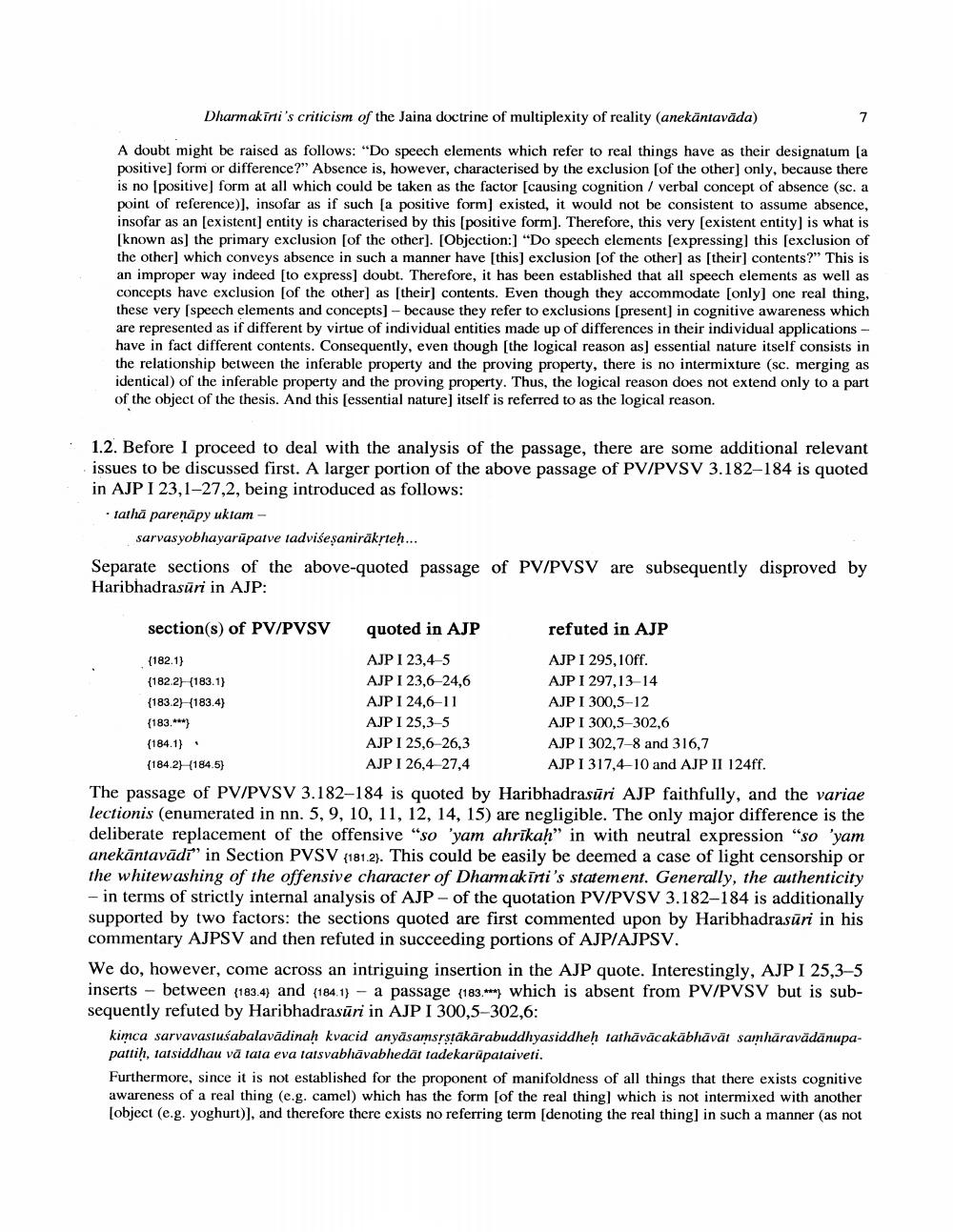Book Title: Dharmakirtis Criticism Of Jaina Doctrine Of Multiplexity Of Reality Anekantavada Author(s): Piotr Balcerowicz Publisher: Piotr Balcerowicz View full book textPage 7
________________ Dharmakirti's criticism of the Jaina doctrine of multiplexity of reality (anekäntavāda) A doubt might be raised as follows: "Do speech elements which refer to real things have as their designatum [a positive) form or difference?" Absence is, however, characterised by the exclusion (of the other) only, because there is no (positive) form at all which could be taken as the factor (causing cognition / verbal concept of absence (sc. a point of reference)], insofar as if such a positive form) existed, it would not be consistent to assume absence, insofar as an [existent) entity is characterised by this (positive form). Therefore, this very (existent entity) is what is [known as the primary exclusion (of the other]. [Objection:] "Do speech elements (expressing this [exclusion of the other) which conveys absence in such a manner have [this] exclusion (of the other) as [their contents?" This is an improper way indeed [to express) doubt. Therefore, it has been established that all speech elements as well as concepts have exclusion (of the other) as [their contents. Even though they accommodate [only] one real thing, these very (speech elements and concepts) - because they refer to exclusions (present) in cognitive awareness which are represented as if different by virtue of individual entities made up of differences in their individual applications - have in fact different contents. Consequently, even though (the logical reason as) essential nature itself consists in the relationship between the inferable property and the proving property, there is no intermixture (sc. merging as identical) of the inferable property and the proving property. Thus, the logical reason does not extend only to a part of the object of the thesis. And this sessential nature] itself is referred to as the logical reason. 1.2. Before I proceed to deal with the analysis of the passage, there are some additional relevant issues to be discussed first. A larger portion of the above passage of PV/PVSV 3.182-184 is quoted in AJP I 23,1-27,2, being introduced as follows: tathā parenāpy uktam - sarvas yobhayarūpalve tadviseşaniräkrteh... Separate sections of the above-quoted passage of PV/PVSV are subsequently disproved by Haribhadrasūri in AJP: section(s) of PV/PVSV quoted in AJP refuted in AJP (182.1) AJP I 23,4-5 AJP I 295, 10ff. (182. 2 183.1} AJP I 23,6-24,6 AJP I 297,13-14 (183.2H183.4) AJP I 24,6-11 AJP I 300,5-12 (183.*** AJP I 25,3-5 AJP I 300,5–302,6 {184.1} AJP I 25,6-26,3 AJP I 302,7–8 and 316,7 (184.2H184.5) AJP I 26,4-27,4 AJP I 317,4-10 and AJP II 124ff. The passage of PV/PVSV 3.182-184 is quoted by Haribhadrasūri AJP faithfully, and the variae lectionis (enumerated in nn. 5, 9, 10, 11, 12, 14, 15) are negligible. The only major difference is the deliberate replacement of the offensive "so'yam ahrīkah" in with neutral expression "so 'yam anekāntavādi" in Section PVSV (181.2). This could be easily be deemed a case of light censorship or the whitewashing of the offensive character of Dharmakirti's statement. Generally, the authenticity - in terms of strictly internal analysis of AJP - of the quotation PV/PVSV 3.182-184 is additionally supported by two factors: the sections quoted are first commented upon by Haribhadrasūri in his commentary AJPSV and then refuted in succeeding portions of AJP/AJPSV. We do, however, come across an intriguing insertion in the AJP quote. Interestingly, AJP I 25,3-5 inserts - between (183.4) and (184.1} - a passage (183.***] which is absent from PV/PVSV but is subsequently refuted by Haribhadrasūri in AJP I 300,5–302,6: kimca sarvavastusabalavādinah kvacid anyäsamsgstākārabuddhyasiddheh tathāvācakābhāvät samhäravädānupapatti, tatsiddhau và taia eva talsvabhāvabledat tadekarapataiveti. Furthermore, since it is not established for the proponent of manifoldness of all things that there exists cognitive awareness of a real thing (e.g. camel) which has the form (of the real thingl which is not intermixed with another [object (e.g. yoghurt)], and therefore there exists no referring term [denoting the real thing) in such a manner (as notPage Navigation
1 ... 5 6 7 8 9 10 11 12 13 14 15 16 17 18 19 20 21 22 23 24 25 26 27 28 29 30
